Business Administration Report: Office Management and Support Details
VerifiedAdded on 2020/07/23
|21
|5364
|27
Report
AI Summary
This business administration report delves into various facets of office management, providing insights into crucial aspects such as handling mail, offering administrative support, and utilizing spreadsheet software. The report explores key concepts within business administration, including the importance of skillful composition in reports, presentation skills, and the significance of communication in a business environment. It further examines strategies for managing office facilities, including problem identification, implementing changes, and monitoring procedures. Additionally, the report covers handling both internal and external mail, emphasizing the importance of security and efficiency. It also addresses providing administrative support, including meeting management and policy adherence, as well as the application of spreadsheet software. Furthermore, the report explores the role of social media in a business context, covering various tasks and considerations. The report is a comprehensive guide to enhance operational efficiency and decision-making within a business setting.
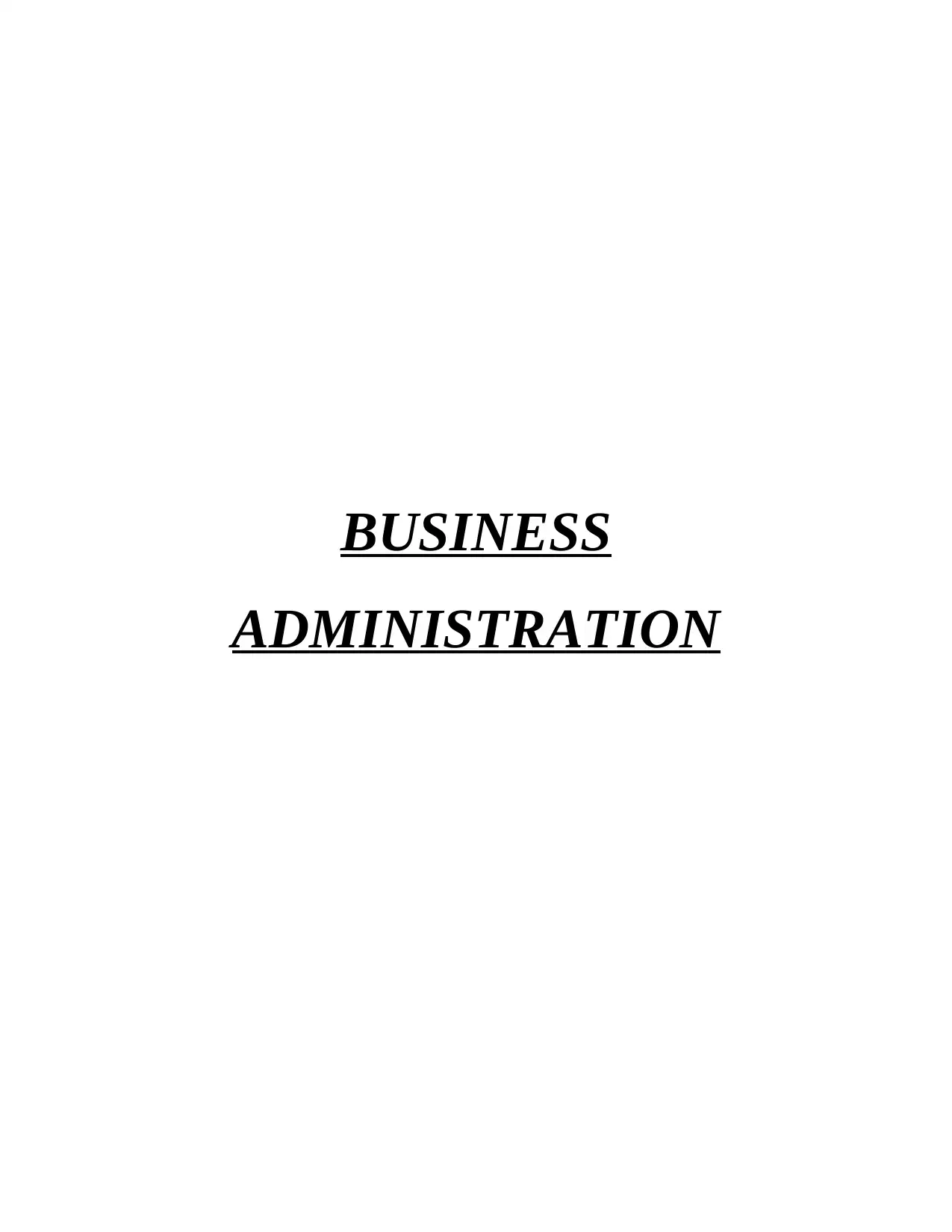
BUSINESS
ADMINISTRATION
ADMINISTRATION
Paraphrase This Document
Need a fresh take? Get an instant paraphrase of this document with our AI Paraphraser
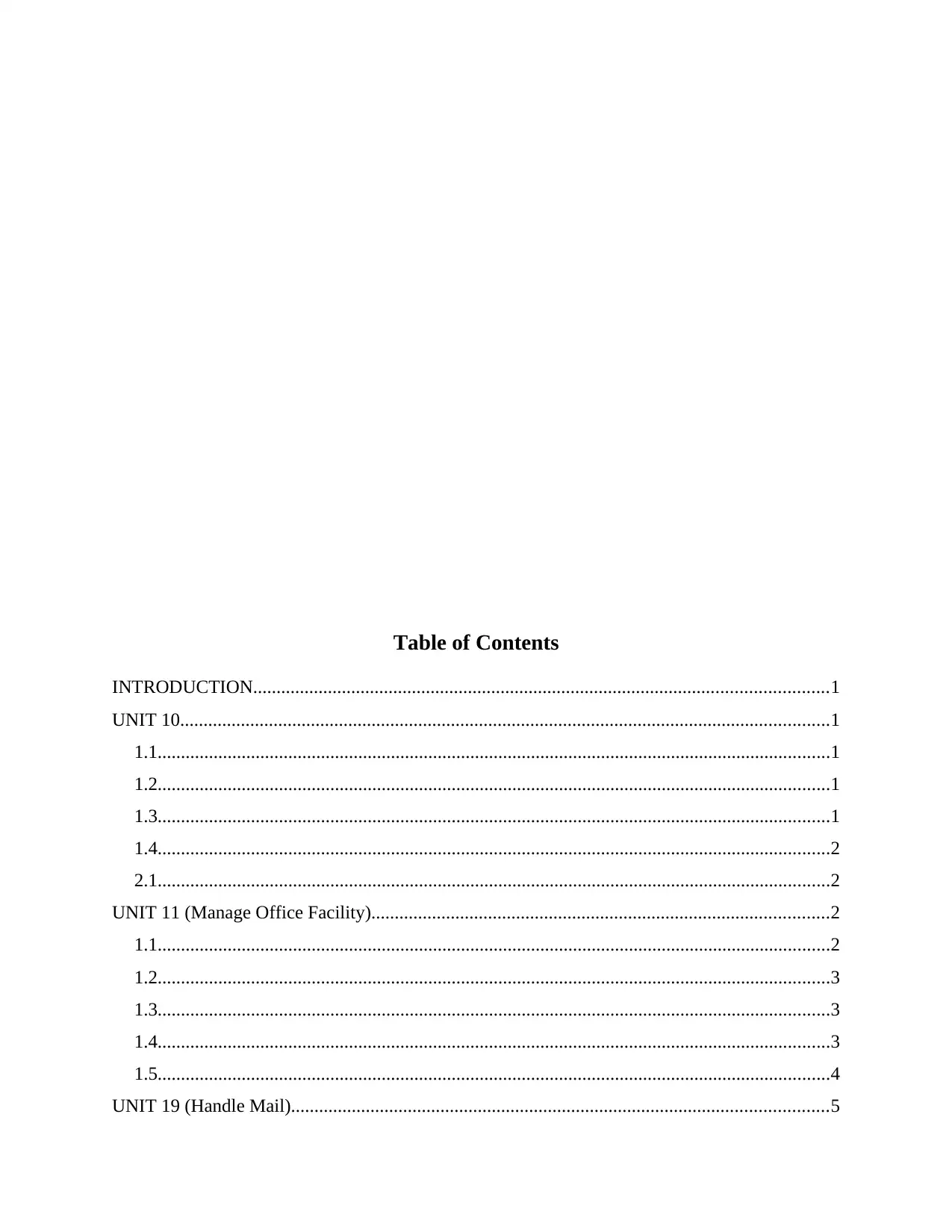
Table of Contents
INTRODUCTION...........................................................................................................................1
UNIT 10...........................................................................................................................................1
1.1................................................................................................................................................1
1.2................................................................................................................................................1
1.3................................................................................................................................................1
1.4................................................................................................................................................2
2.1................................................................................................................................................2
UNIT 11 (Manage Office Facility)..................................................................................................2
1.1................................................................................................................................................2
1.2................................................................................................................................................3
1.3................................................................................................................................................3
1.4................................................................................................................................................3
1.5................................................................................................................................................4
UNIT 19 (Handle Mail)...................................................................................................................5
INTRODUCTION...........................................................................................................................1
UNIT 10...........................................................................................................................................1
1.1................................................................................................................................................1
1.2................................................................................................................................................1
1.3................................................................................................................................................1
1.4................................................................................................................................................2
2.1................................................................................................................................................2
UNIT 11 (Manage Office Facility)..................................................................................................2
1.1................................................................................................................................................2
1.2................................................................................................................................................3
1.3................................................................................................................................................3
1.4................................................................................................................................................3
1.5................................................................................................................................................4
UNIT 19 (Handle Mail)...................................................................................................................5
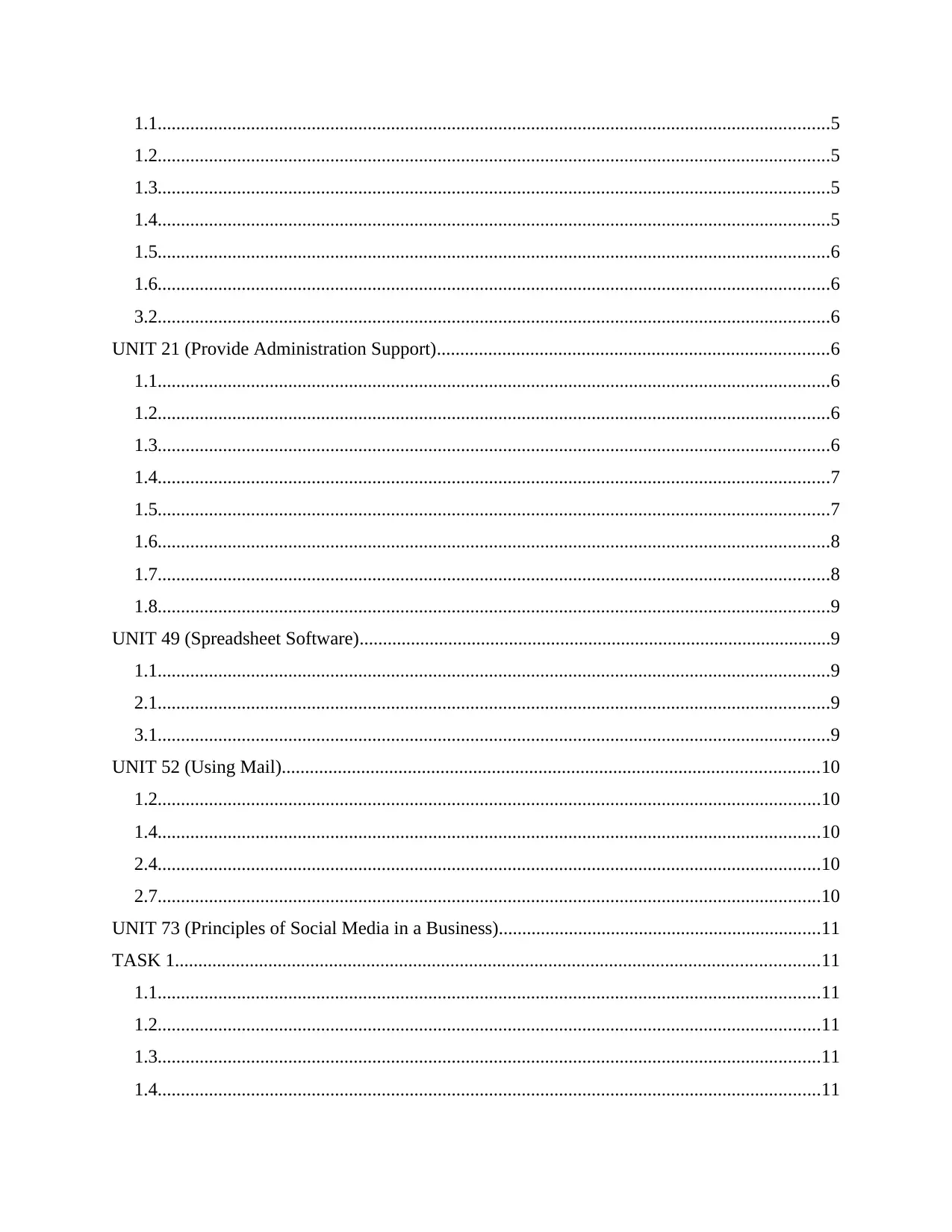
1.1................................................................................................................................................5
1.2................................................................................................................................................5
1.3................................................................................................................................................5
1.4................................................................................................................................................5
1.5................................................................................................................................................6
1.6................................................................................................................................................6
3.2................................................................................................................................................6
UNIT 21 (Provide Administration Support)....................................................................................6
1.1................................................................................................................................................6
1.2................................................................................................................................................6
1.3................................................................................................................................................6
1.4................................................................................................................................................7
1.5................................................................................................................................................7
1.6................................................................................................................................................8
1.7................................................................................................................................................8
1.8................................................................................................................................................9
UNIT 49 (Spreadsheet Software).....................................................................................................9
1.1................................................................................................................................................9
2.1................................................................................................................................................9
3.1................................................................................................................................................9
UNIT 52 (Using Mail)...................................................................................................................10
1.2..............................................................................................................................................10
1.4..............................................................................................................................................10
2.4..............................................................................................................................................10
2.7..............................................................................................................................................10
UNIT 73 (Principles of Social Media in a Business).....................................................................11
TASK 1..........................................................................................................................................11
1.1..............................................................................................................................................11
1.2..............................................................................................................................................11
1.3..............................................................................................................................................11
1.4..............................................................................................................................................11
1.2................................................................................................................................................5
1.3................................................................................................................................................5
1.4................................................................................................................................................5
1.5................................................................................................................................................6
1.6................................................................................................................................................6
3.2................................................................................................................................................6
UNIT 21 (Provide Administration Support)....................................................................................6
1.1................................................................................................................................................6
1.2................................................................................................................................................6
1.3................................................................................................................................................6
1.4................................................................................................................................................7
1.5................................................................................................................................................7
1.6................................................................................................................................................8
1.7................................................................................................................................................8
1.8................................................................................................................................................9
UNIT 49 (Spreadsheet Software).....................................................................................................9
1.1................................................................................................................................................9
2.1................................................................................................................................................9
3.1................................................................................................................................................9
UNIT 52 (Using Mail)...................................................................................................................10
1.2..............................................................................................................................................10
1.4..............................................................................................................................................10
2.4..............................................................................................................................................10
2.7..............................................................................................................................................10
UNIT 73 (Principles of Social Media in a Business).....................................................................11
TASK 1..........................................................................................................................................11
1.1..............................................................................................................................................11
1.2..............................................................................................................................................11
1.3..............................................................................................................................................11
1.4..............................................................................................................................................11
⊘ This is a preview!⊘
Do you want full access?
Subscribe today to unlock all pages.

Trusted by 1+ million students worldwide
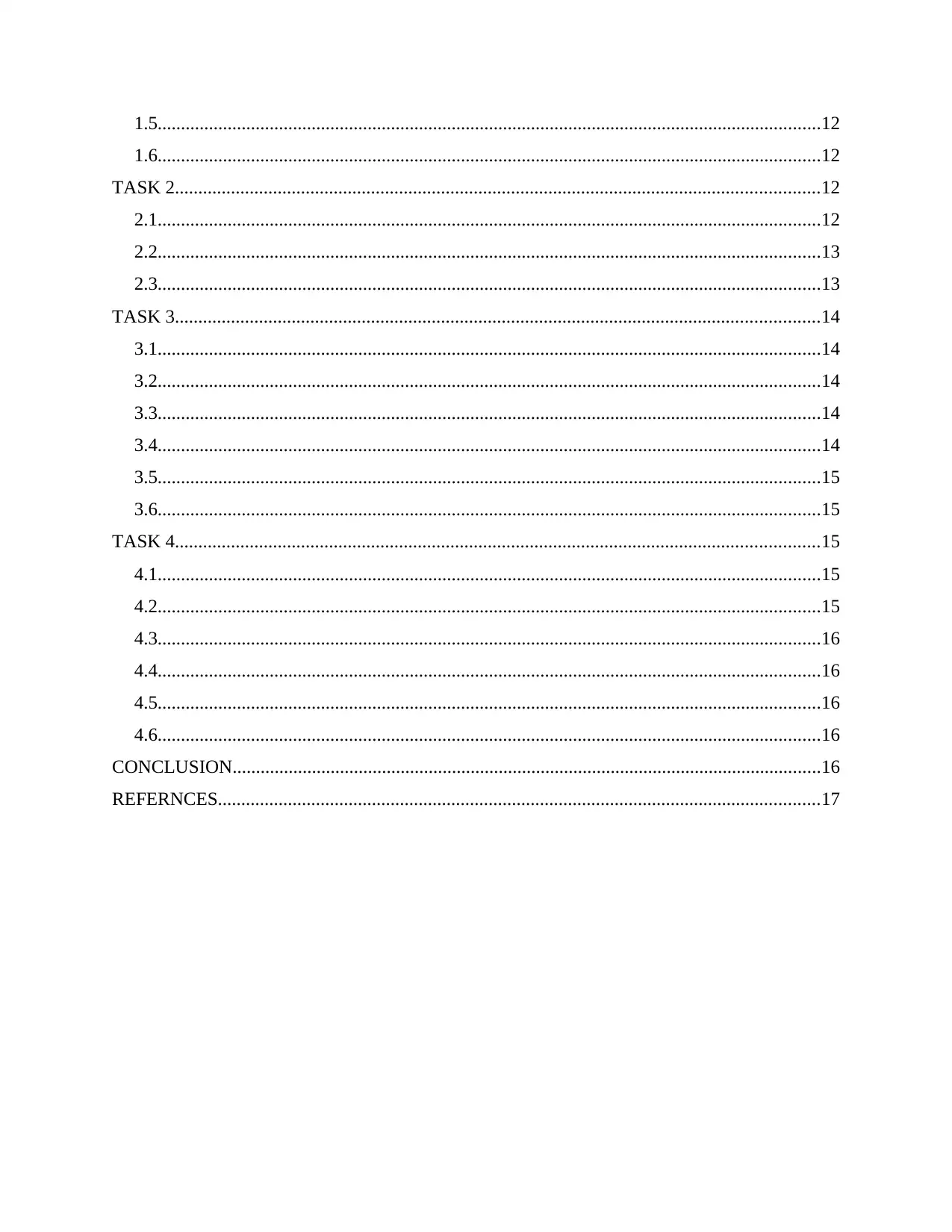
1.5..............................................................................................................................................12
1.6..............................................................................................................................................12
TASK 2..........................................................................................................................................12
2.1..............................................................................................................................................12
2.2..............................................................................................................................................13
2.3..............................................................................................................................................13
TASK 3..........................................................................................................................................14
3.1..............................................................................................................................................14
3.2..............................................................................................................................................14
3.3..............................................................................................................................................14
3.4..............................................................................................................................................14
3.5..............................................................................................................................................15
3.6..............................................................................................................................................15
TASK 4..........................................................................................................................................15
4.1..............................................................................................................................................15
4.2..............................................................................................................................................15
4.3..............................................................................................................................................16
4.4..............................................................................................................................................16
4.5..............................................................................................................................................16
4.6..............................................................................................................................................16
CONCLUSION..............................................................................................................................16
REFERNCES.................................................................................................................................17
1.6..............................................................................................................................................12
TASK 2..........................................................................................................................................12
2.1..............................................................................................................................................12
2.2..............................................................................................................................................13
2.3..............................................................................................................................................13
TASK 3..........................................................................................................................................14
3.1..............................................................................................................................................14
3.2..............................................................................................................................................14
3.3..............................................................................................................................................14
3.4..............................................................................................................................................14
3.5..............................................................................................................................................15
3.6..............................................................................................................................................15
TASK 4..........................................................................................................................................15
4.1..............................................................................................................................................15
4.2..............................................................................................................................................15
4.3..............................................................................................................................................16
4.4..............................................................................................................................................16
4.5..............................................................................................................................................16
4.6..............................................................................................................................................16
CONCLUSION..............................................................................................................................16
REFERNCES.................................................................................................................................17
Paraphrase This Document
Need a fresh take? Get an instant paraphrase of this document with our AI Paraphraser
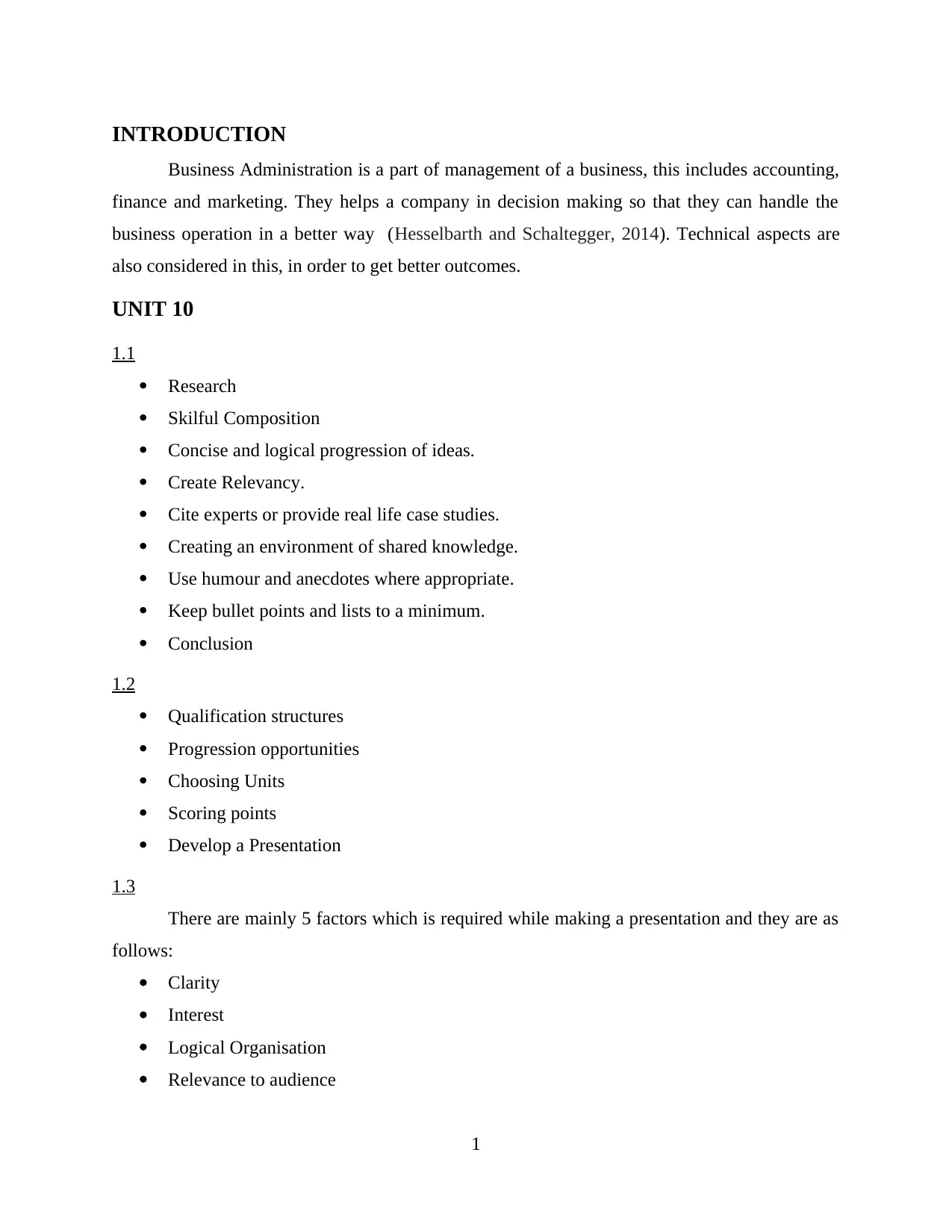
INTRODUCTION
Business Administration is a part of management of a business, this includes accounting,
finance and marketing. They helps a company in decision making so that they can handle the
business operation in a better way (Hesselbarth and Schaltegger, 2014). Technical aspects are
also considered in this, in order to get better outcomes.
UNIT 10
1.1
Research
Skilful Composition
Concise and logical progression of ideas.
Create Relevancy.
Cite experts or provide real life case studies.
Creating an environment of shared knowledge.
Use humour and anecdotes where appropriate.
Keep bullet points and lists to a minimum.
Conclusion
1.2
Qualification structures
Progression opportunities
Choosing Units
Scoring points
Develop a Presentation
1.3
There are mainly 5 factors which is required while making a presentation and they are as
follows:
Clarity
Interest
Logical Organisation
Relevance to audience
1
Business Administration is a part of management of a business, this includes accounting,
finance and marketing. They helps a company in decision making so that they can handle the
business operation in a better way (Hesselbarth and Schaltegger, 2014). Technical aspects are
also considered in this, in order to get better outcomes.
UNIT 10
1.1
Research
Skilful Composition
Concise and logical progression of ideas.
Create Relevancy.
Cite experts or provide real life case studies.
Creating an environment of shared knowledge.
Use humour and anecdotes where appropriate.
Keep bullet points and lists to a minimum.
Conclusion
1.2
Qualification structures
Progression opportunities
Choosing Units
Scoring points
Develop a Presentation
1.3
There are mainly 5 factors which is required while making a presentation and they are as
follows:
Clarity
Interest
Logical Organisation
Relevance to audience
1
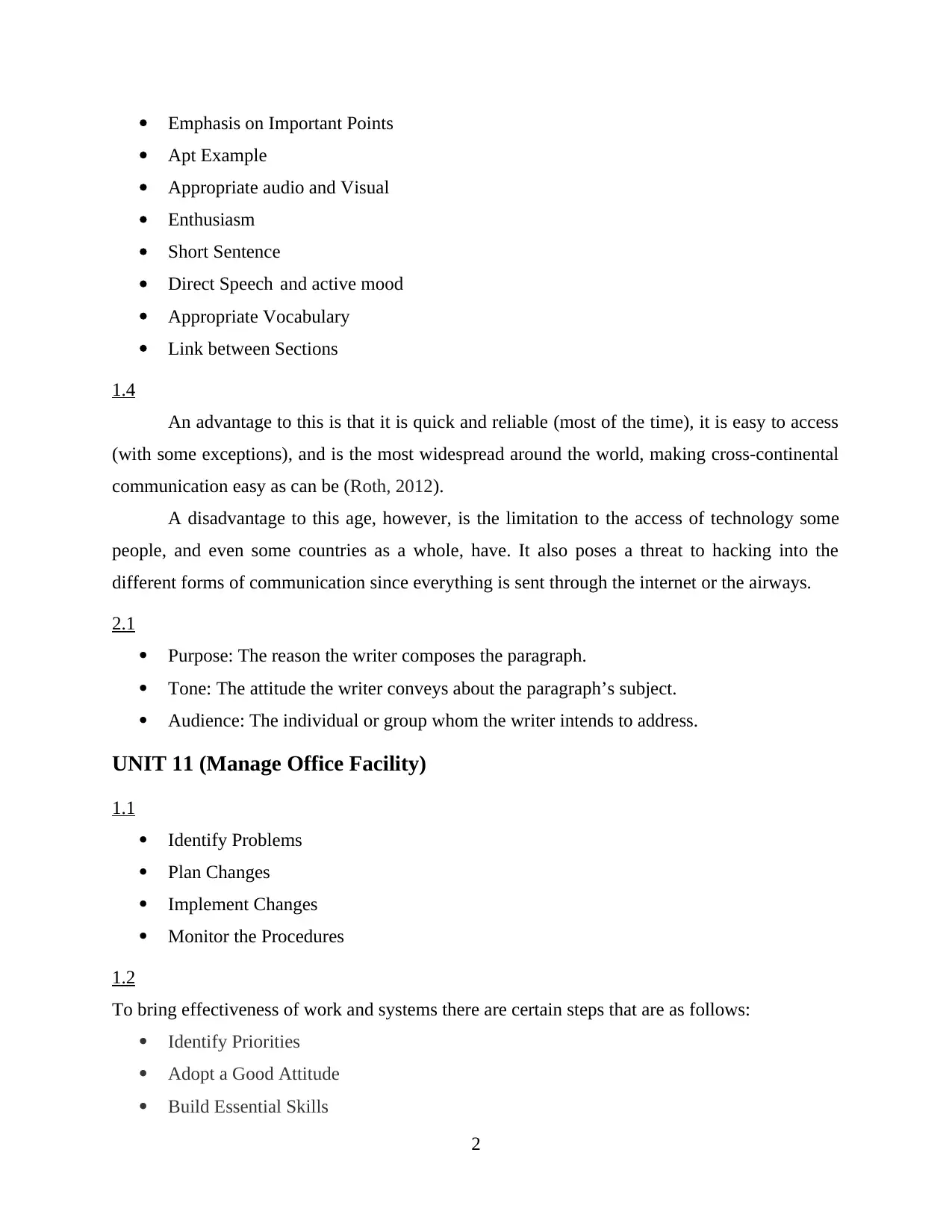
Emphasis on Important Points
Apt Example
Appropriate audio and Visual
Enthusiasm
Short Sentence
Direct Speech and active mood
Appropriate Vocabulary
Link between Sections
1.4
An advantage to this is that it is quick and reliable (most of the time), it is easy to access
(with some exceptions), and is the most widespread around the world, making cross-continental
communication easy as can be (Roth, 2012).
A disadvantage to this age, however, is the limitation to the access of technology some
people, and even some countries as a whole, have. It also poses a threat to hacking into the
different forms of communication since everything is sent through the internet or the airways.
2.1
Purpose: The reason the writer composes the paragraph.
Tone: The attitude the writer conveys about the paragraph’s subject.
Audience: The individual or group whom the writer intends to address.
UNIT 11 (Manage Office Facility)
1.1
Identify Problems
Plan Changes
Implement Changes
Monitor the Procedures
1.2
To bring effectiveness of work and systems there are certain steps that are as follows:
Identify Priorities
Adopt a Good Attitude
Build Essential Skills
2
Apt Example
Appropriate audio and Visual
Enthusiasm
Short Sentence
Direct Speech and active mood
Appropriate Vocabulary
Link between Sections
1.4
An advantage to this is that it is quick and reliable (most of the time), it is easy to access
(with some exceptions), and is the most widespread around the world, making cross-continental
communication easy as can be (Roth, 2012).
A disadvantage to this age, however, is the limitation to the access of technology some
people, and even some countries as a whole, have. It also poses a threat to hacking into the
different forms of communication since everything is sent through the internet or the airways.
2.1
Purpose: The reason the writer composes the paragraph.
Tone: The attitude the writer conveys about the paragraph’s subject.
Audience: The individual or group whom the writer intends to address.
UNIT 11 (Manage Office Facility)
1.1
Identify Problems
Plan Changes
Implement Changes
Monitor the Procedures
1.2
To bring effectiveness of work and systems there are certain steps that are as follows:
Identify Priorities
Adopt a Good Attitude
Build Essential Skills
2
⊘ This is a preview!⊘
Do you want full access?
Subscribe today to unlock all pages.

Trusted by 1+ million students worldwide
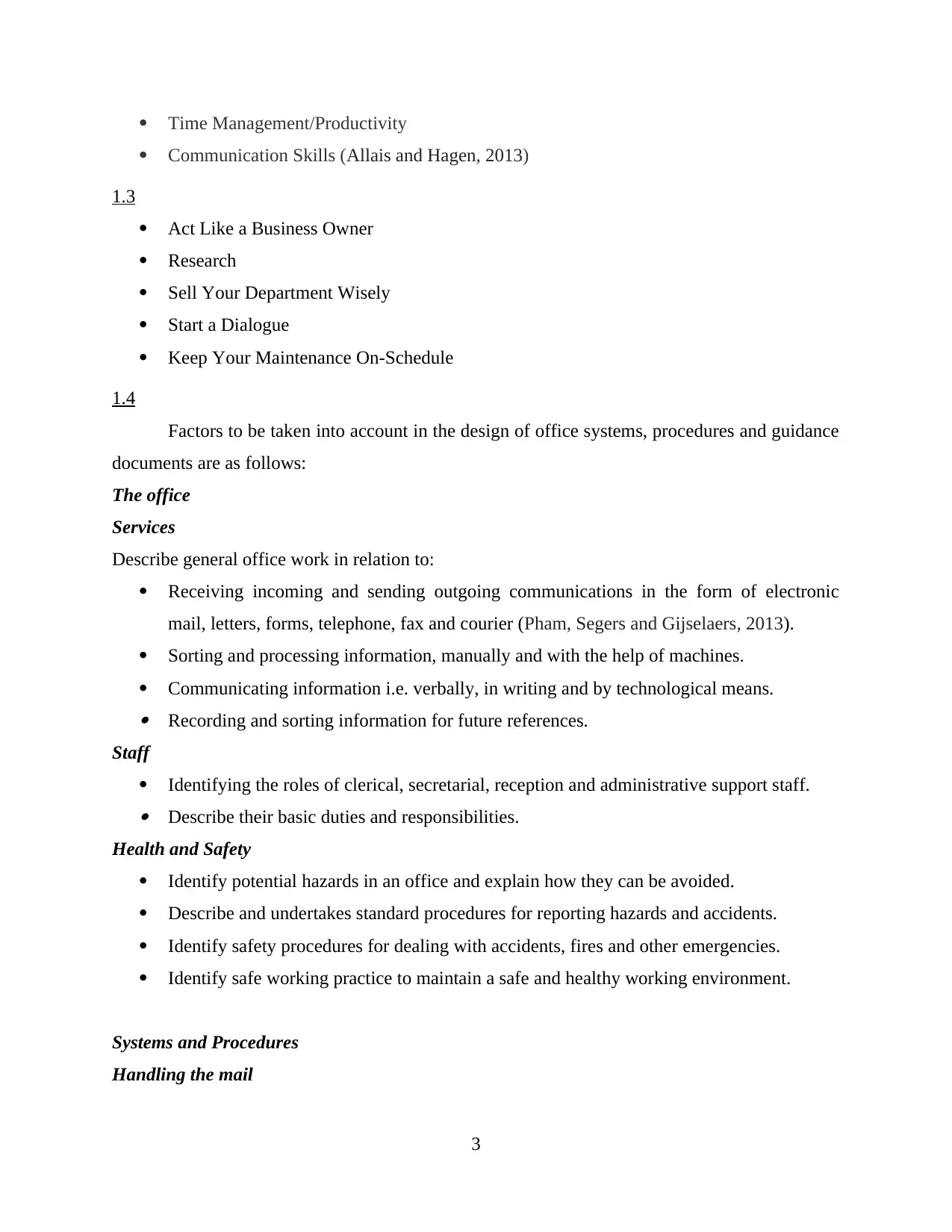
Time Management/Productivity
Communication Skills (Allais and Hagen, 2013)
1.3
Act Like a Business Owner
Research
Sell Your Department Wisely
Start a Dialogue
Keep Your Maintenance On-Schedule
1.4
Factors to be taken into account in the design of office systems, procedures and guidance
documents are as follows:
The office
Services
Describe general office work in relation to:
Receiving incoming and sending outgoing communications in the form of electronic
mail, letters, forms, telephone, fax and courier (Pham, Segers and Gijselaers, 2013).
Sorting and processing information, manually and with the help of machines.
Communicating information i.e. verbally, in writing and by technological means. Recording and sorting information for future references.
Staff
Identifying the roles of clerical, secretarial, reception and administrative support staff. Describe their basic duties and responsibilities.
Health and Safety
Identify potential hazards in an office and explain how they can be avoided.
Describe and undertakes standard procedures for reporting hazards and accidents.
Identify safety procedures for dealing with accidents, fires and other emergencies.
Identify safe working practice to maintain a safe and healthy working environment.
Systems and Procedures
Handling the mail
3
Communication Skills (Allais and Hagen, 2013)
1.3
Act Like a Business Owner
Research
Sell Your Department Wisely
Start a Dialogue
Keep Your Maintenance On-Schedule
1.4
Factors to be taken into account in the design of office systems, procedures and guidance
documents are as follows:
The office
Services
Describe general office work in relation to:
Receiving incoming and sending outgoing communications in the form of electronic
mail, letters, forms, telephone, fax and courier (Pham, Segers and Gijselaers, 2013).
Sorting and processing information, manually and with the help of machines.
Communicating information i.e. verbally, in writing and by technological means. Recording and sorting information for future references.
Staff
Identifying the roles of clerical, secretarial, reception and administrative support staff. Describe their basic duties and responsibilities.
Health and Safety
Identify potential hazards in an office and explain how they can be avoided.
Describe and undertakes standard procedures for reporting hazards and accidents.
Identify safety procedures for dealing with accidents, fires and other emergencies.
Identify safe working practice to maintain a safe and healthy working environment.
Systems and Procedures
Handling the mail
3
Paraphrase This Document
Need a fresh take? Get an instant paraphrase of this document with our AI Paraphraser
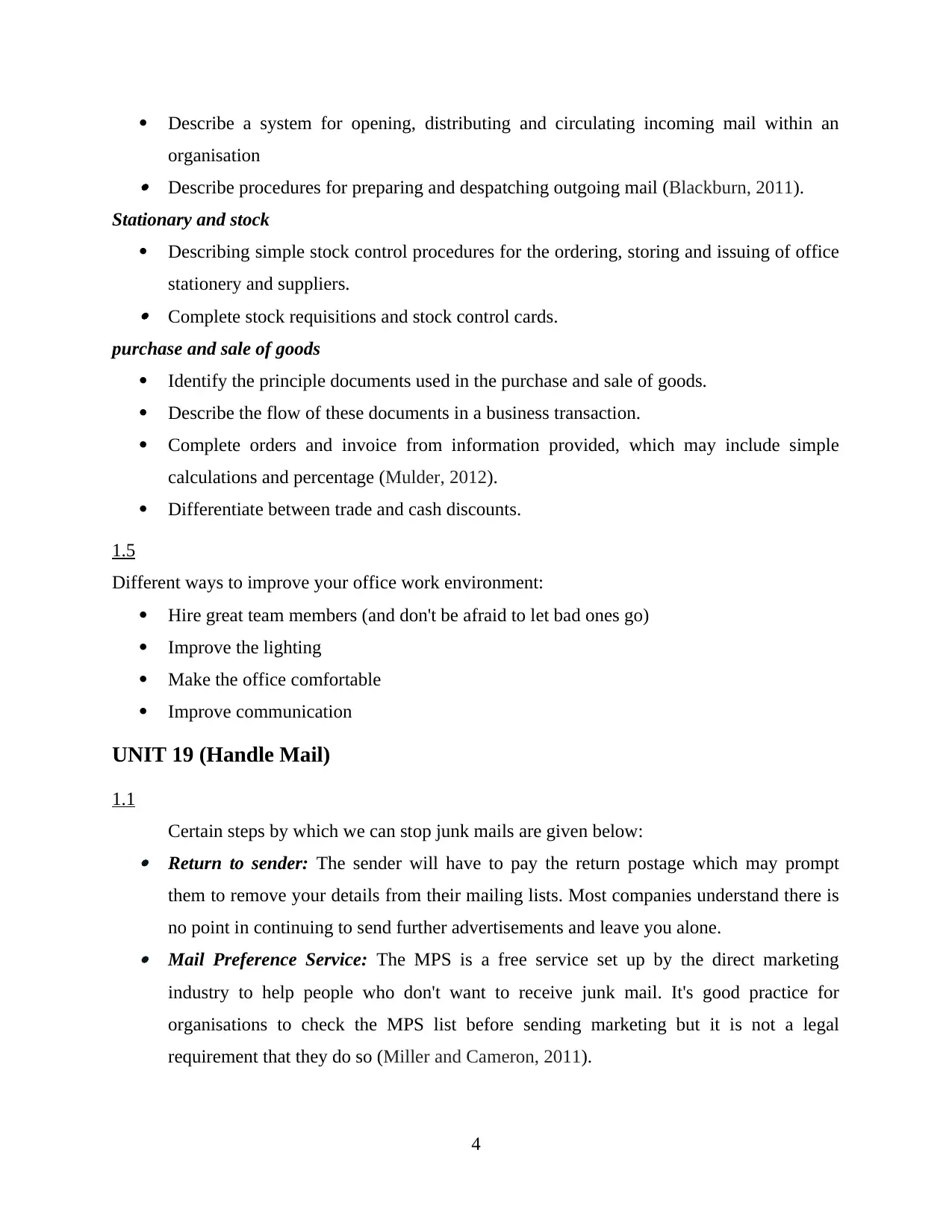
Describe a system for opening, distributing and circulating incoming mail within an
organisation Describe procedures for preparing and despatching outgoing mail (Blackburn, 2011).
Stationary and stock
Describing simple stock control procedures for the ordering, storing and issuing of office
stationery and suppliers. Complete stock requisitions and stock control cards.
purchase and sale of goods
Identify the principle documents used in the purchase and sale of goods.
Describe the flow of these documents in a business transaction.
Complete orders and invoice from information provided, which may include simple
calculations and percentage (Mulder, 2012).
Differentiate between trade and cash discounts.
1.5
Different ways to improve your office work environment:
Hire great team members (and don't be afraid to let bad ones go)
Improve the lighting
Make the office comfortable
Improve communication
UNIT 19 (Handle Mail)
1.1
Certain steps by which we can stop junk mails are given below: Return to sender: The sender will have to pay the return postage which may prompt
them to remove your details from their mailing lists. Most companies understand there is
no point in continuing to send further advertisements and leave you alone. Mail Preference Service: The MPS is a free service set up by the direct marketing
industry to help people who don't want to receive junk mail. It's good practice for
organisations to check the MPS list before sending marketing but it is not a legal
requirement that they do so (Miller and Cameron, 2011).
4
organisation Describe procedures for preparing and despatching outgoing mail (Blackburn, 2011).
Stationary and stock
Describing simple stock control procedures for the ordering, storing and issuing of office
stationery and suppliers. Complete stock requisitions and stock control cards.
purchase and sale of goods
Identify the principle documents used in the purchase and sale of goods.
Describe the flow of these documents in a business transaction.
Complete orders and invoice from information provided, which may include simple
calculations and percentage (Mulder, 2012).
Differentiate between trade and cash discounts.
1.5
Different ways to improve your office work environment:
Hire great team members (and don't be afraid to let bad ones go)
Improve the lighting
Make the office comfortable
Improve communication
UNIT 19 (Handle Mail)
1.1
Certain steps by which we can stop junk mails are given below: Return to sender: The sender will have to pay the return postage which may prompt
them to remove your details from their mailing lists. Most companies understand there is
no point in continuing to send further advertisements and leave you alone. Mail Preference Service: The MPS is a free service set up by the direct marketing
industry to help people who don't want to receive junk mail. It's good practice for
organisations to check the MPS list before sending marketing but it is not a legal
requirement that they do so (Miller and Cameron, 2011).
4
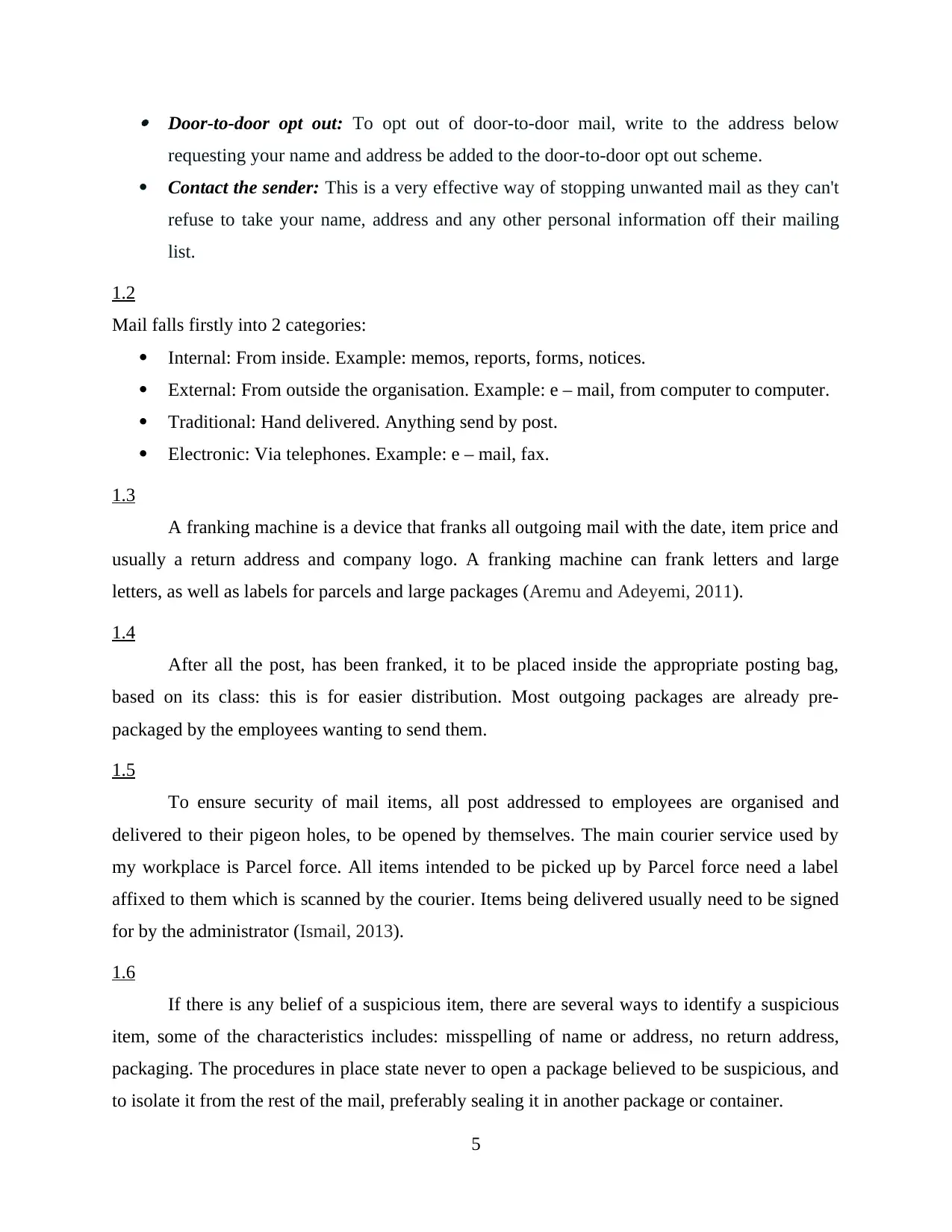
Door-to-door opt out: To opt out of door-to-door mail, write to the address below
requesting your name and address be added to the door-to-door opt out scheme.
Contact the sender: This is a very effective way of stopping unwanted mail as they can't
refuse to take your name, address and any other personal information off their mailing
list.
1.2
Mail falls firstly into 2 categories:
Internal: From inside. Example: memos, reports, forms, notices.
External: From outside the organisation. Example: e – mail, from computer to computer.
Traditional: Hand delivered. Anything send by post.
Electronic: Via telephones. Example: e – mail, fax.
1.3
A franking machine is a device that franks all outgoing mail with the date, item price and
usually a return address and company logo. A franking machine can frank letters and large
letters, as well as labels for parcels and large packages (Aremu and Adeyemi, 2011).
1.4
After all the post, has been franked, it to be placed inside the appropriate posting bag,
based on its class: this is for easier distribution. Most outgoing packages are already pre-
packaged by the employees wanting to send them.
1.5
To ensure security of mail items, all post addressed to employees are organised and
delivered to their pigeon holes, to be opened by themselves. The main courier service used by
my workplace is Parcel force. All items intended to be picked up by Parcel force need a label
affixed to them which is scanned by the courier. Items being delivered usually need to be signed
for by the administrator (Ismail, 2013).
1.6
If there is any belief of a suspicious item, there are several ways to identify a suspicious
item, some of the characteristics includes: misspelling of name or address, no return address,
packaging. The procedures in place state never to open a package believed to be suspicious, and
to isolate it from the rest of the mail, preferably sealing it in another package or container.
5
requesting your name and address be added to the door-to-door opt out scheme.
Contact the sender: This is a very effective way of stopping unwanted mail as they can't
refuse to take your name, address and any other personal information off their mailing
list.
1.2
Mail falls firstly into 2 categories:
Internal: From inside. Example: memos, reports, forms, notices.
External: From outside the organisation. Example: e – mail, from computer to computer.
Traditional: Hand delivered. Anything send by post.
Electronic: Via telephones. Example: e – mail, fax.
1.3
A franking machine is a device that franks all outgoing mail with the date, item price and
usually a return address and company logo. A franking machine can frank letters and large
letters, as well as labels for parcels and large packages (Aremu and Adeyemi, 2011).
1.4
After all the post, has been franked, it to be placed inside the appropriate posting bag,
based on its class: this is for easier distribution. Most outgoing packages are already pre-
packaged by the employees wanting to send them.
1.5
To ensure security of mail items, all post addressed to employees are organised and
delivered to their pigeon holes, to be opened by themselves. The main courier service used by
my workplace is Parcel force. All items intended to be picked up by Parcel force need a label
affixed to them which is scanned by the courier. Items being delivered usually need to be signed
for by the administrator (Ismail, 2013).
1.6
If there is any belief of a suspicious item, there are several ways to identify a suspicious
item, some of the characteristics includes: misspelling of name or address, no return address,
packaging. The procedures in place state never to open a package believed to be suspicious, and
to isolate it from the rest of the mail, preferably sealing it in another package or container.
5
⊘ This is a preview!⊘
Do you want full access?
Subscribe today to unlock all pages.

Trusted by 1+ million students worldwide
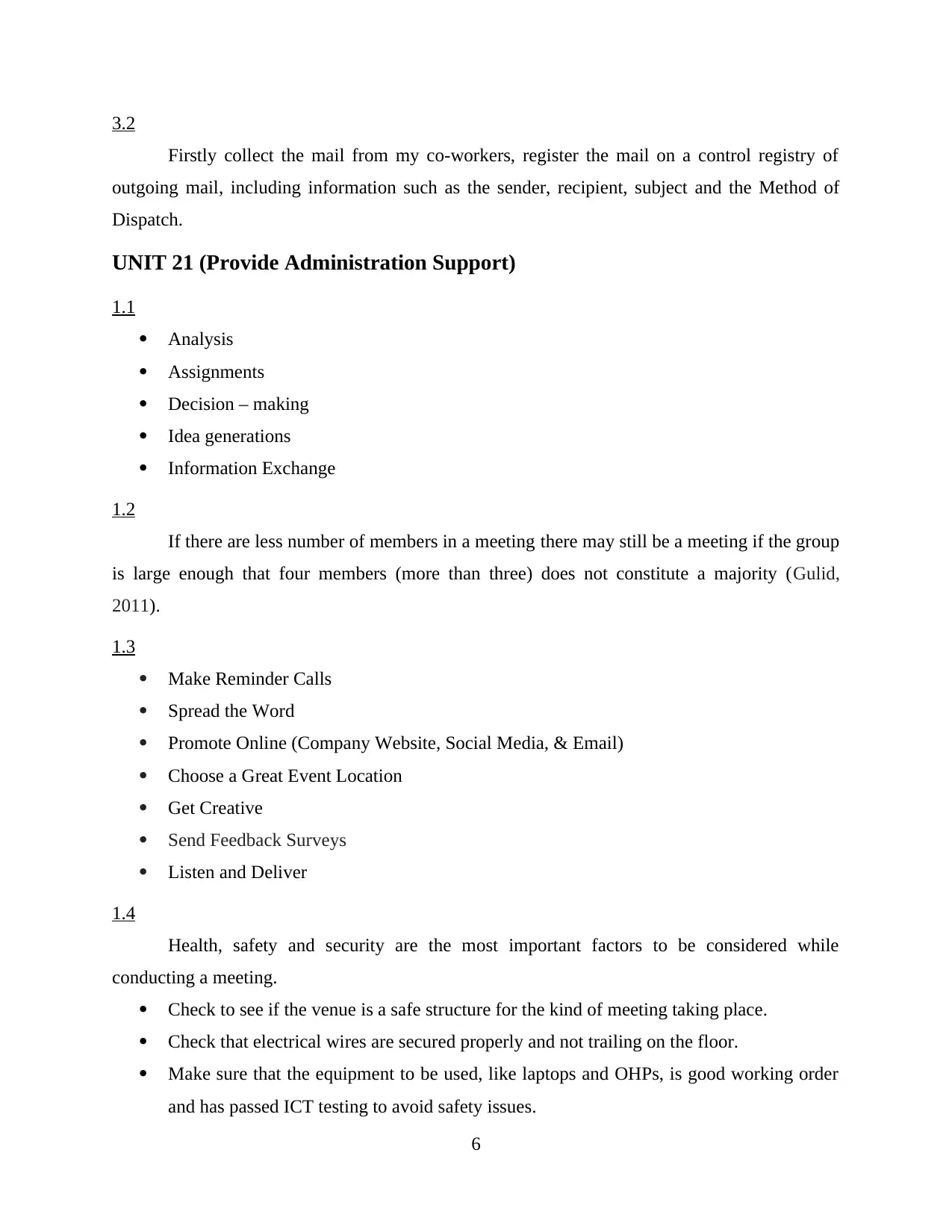
3.2
Firstly collect the mail from my co-workers, register the mail on a control registry of
outgoing mail, including information such as the sender, recipient, subject and the Method of
Dispatch.
UNIT 21 (Provide Administration Support)
1.1
Analysis
Assignments
Decision – making
Idea generations
Information Exchange
1.2
If there are less number of members in a meeting there may still be a meeting if the group
is large enough that four members (more than three) does not constitute a majority (Gulid,
2011).
1.3
Make Reminder Calls
Spread the Word
Promote Online (Company Website, Social Media, & Email)
Choose a Great Event Location
Get Creative
Send Feedback Surveys
Listen and Deliver
1.4
Health, safety and security are the most important factors to be considered while
conducting a meeting.
Check to see if the venue is a safe structure for the kind of meeting taking place.
Check that electrical wires are secured properly and not trailing on the floor.
Make sure that the equipment to be used, like laptops and OHPs, is good working order
and has passed ICT testing to avoid safety issues.
6
Firstly collect the mail from my co-workers, register the mail on a control registry of
outgoing mail, including information such as the sender, recipient, subject and the Method of
Dispatch.
UNIT 21 (Provide Administration Support)
1.1
Analysis
Assignments
Decision – making
Idea generations
Information Exchange
1.2
If there are less number of members in a meeting there may still be a meeting if the group
is large enough that four members (more than three) does not constitute a majority (Gulid,
2011).
1.3
Make Reminder Calls
Spread the Word
Promote Online (Company Website, Social Media, & Email)
Choose a Great Event Location
Get Creative
Send Feedback Surveys
Listen and Deliver
1.4
Health, safety and security are the most important factors to be considered while
conducting a meeting.
Check to see if the venue is a safe structure for the kind of meeting taking place.
Check that electrical wires are secured properly and not trailing on the floor.
Make sure that the equipment to be used, like laptops and OHPs, is good working order
and has passed ICT testing to avoid safety issues.
6
Paraphrase This Document
Need a fresh take? Get an instant paraphrase of this document with our AI Paraphraser
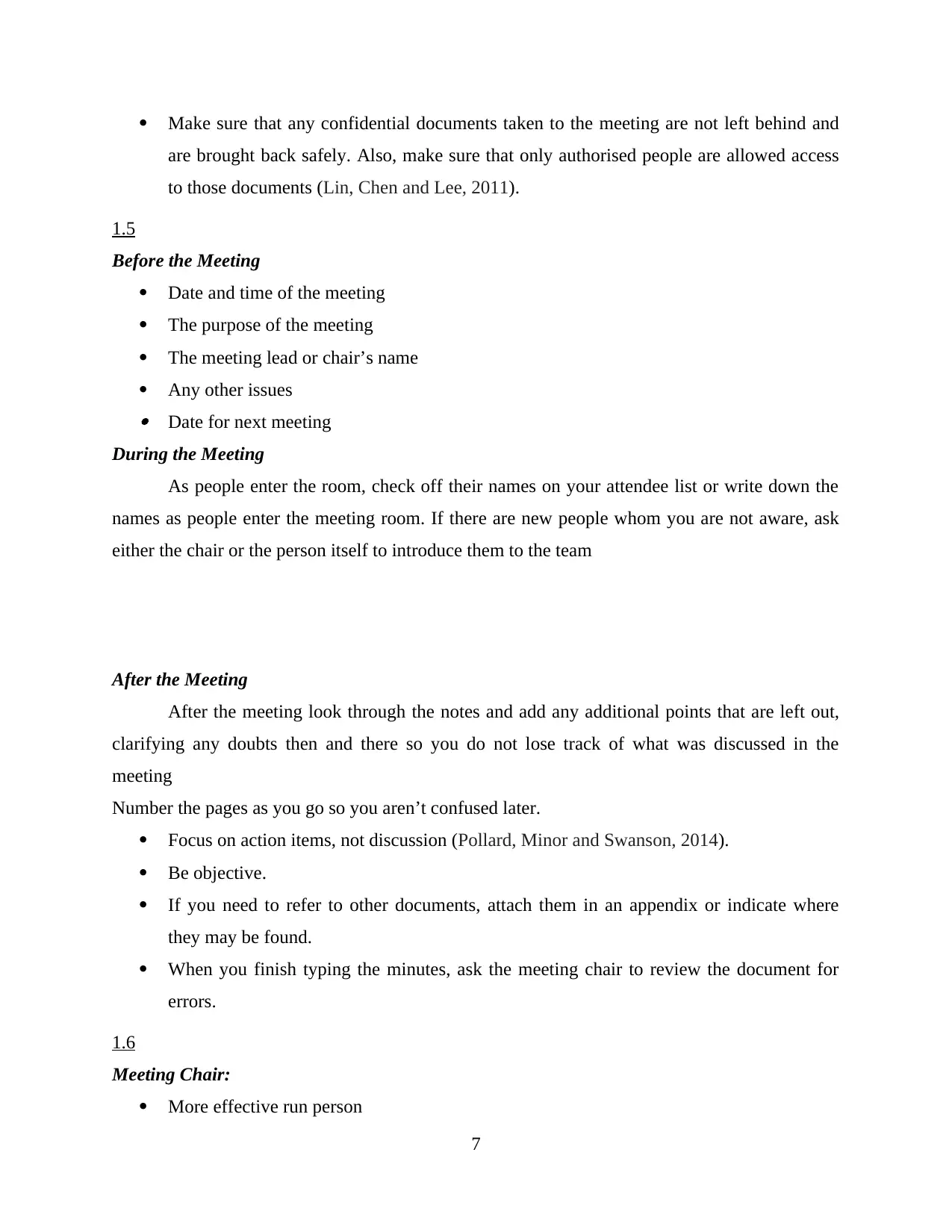
Make sure that any confidential documents taken to the meeting are not left behind and
are brought back safely. Also, make sure that only authorised people are allowed access
to those documents (Lin, Chen and Lee, 2011).
1.5
Before the Meeting
Date and time of the meeting
The purpose of the meeting
The meeting lead or chair’s name
Any other issues Date for next meeting
During the Meeting
As people enter the room, check off their names on your attendee list or write down the
names as people enter the meeting room. If there are new people whom you are not aware, ask
either the chair or the person itself to introduce them to the team
After the Meeting
After the meeting look through the notes and add any additional points that are left out,
clarifying any doubts then and there so you do not lose track of what was discussed in the
meeting
Number the pages as you go so you aren’t confused later.
Focus on action items, not discussion (Pollard, Minor and Swanson, 2014).
Be objective.
If you need to refer to other documents, attach them in an appendix or indicate where
they may be found.
When you finish typing the minutes, ask the meeting chair to review the document for
errors.
1.6
Meeting Chair:
More effective run person
7
are brought back safely. Also, make sure that only authorised people are allowed access
to those documents (Lin, Chen and Lee, 2011).
1.5
Before the Meeting
Date and time of the meeting
The purpose of the meeting
The meeting lead or chair’s name
Any other issues Date for next meeting
During the Meeting
As people enter the room, check off their names on your attendee list or write down the
names as people enter the meeting room. If there are new people whom you are not aware, ask
either the chair or the person itself to introduce them to the team
After the Meeting
After the meeting look through the notes and add any additional points that are left out,
clarifying any doubts then and there so you do not lose track of what was discussed in the
meeting
Number the pages as you go so you aren’t confused later.
Focus on action items, not discussion (Pollard, Minor and Swanson, 2014).
Be objective.
If you need to refer to other documents, attach them in an appendix or indicate where
they may be found.
When you finish typing the minutes, ask the meeting chair to review the document for
errors.
1.6
Meeting Chair:
More effective run person
7
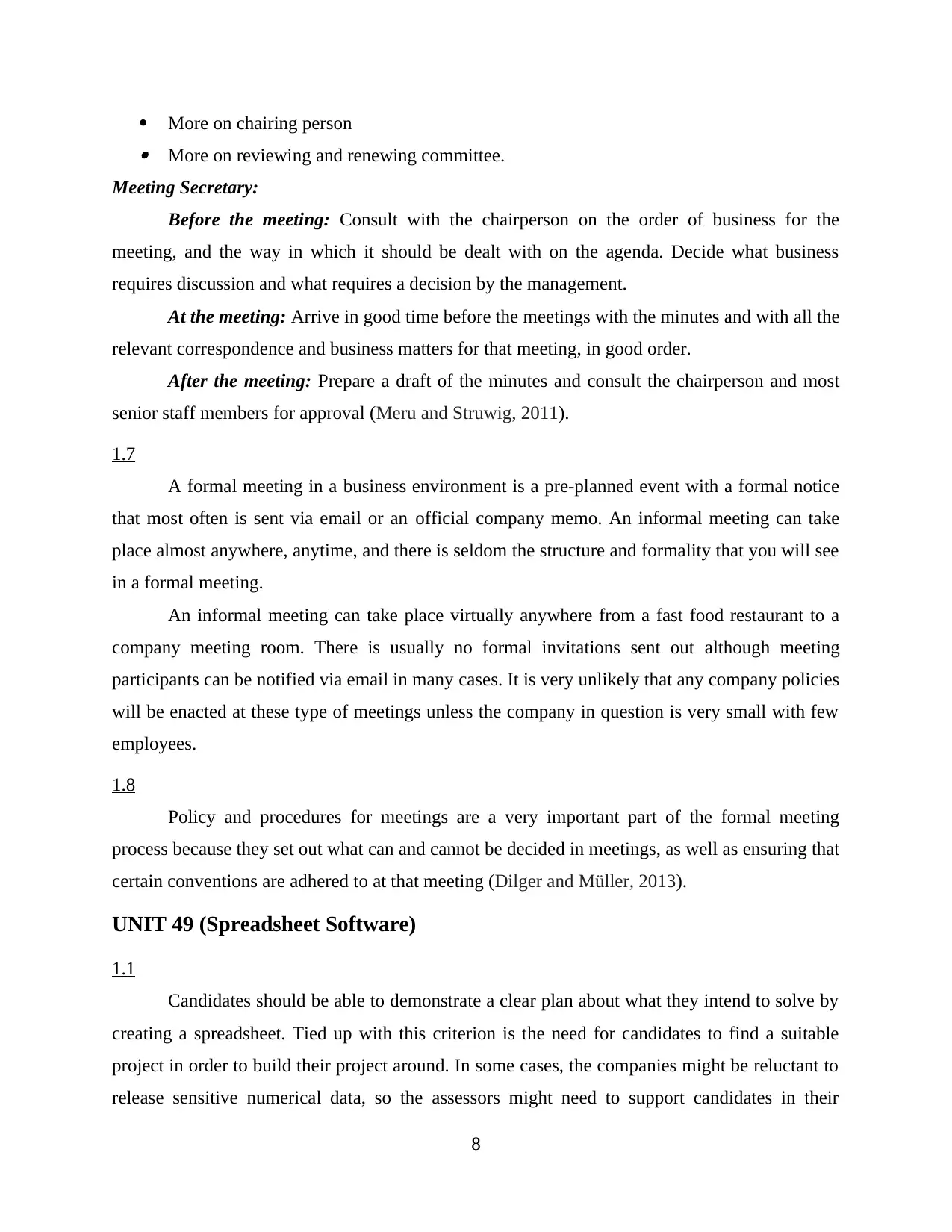
More on chairing person More on reviewing and renewing committee.
Meeting Secretary:
Before the meeting: Consult with the chairperson on the order of business for the
meeting, and the way in which it should be dealt with on the agenda. Decide what business
requires discussion and what requires a decision by the management.
At the meeting: Arrive in good time before the meetings with the minutes and with all the
relevant correspondence and business matters for that meeting, in good order.
After the meeting: Prepare a draft of the minutes and consult the chairperson and most
senior staff members for approval (Meru and Struwig, 2011).
1.7
A formal meeting in a business environment is a pre-planned event with a formal notice
that most often is sent via email or an official company memo. An informal meeting can take
place almost anywhere, anytime, and there is seldom the structure and formality that you will see
in a formal meeting.
An informal meeting can take place virtually anywhere from a fast food restaurant to a
company meeting room. There is usually no formal invitations sent out although meeting
participants can be notified via email in many cases. It is very unlikely that any company policies
will be enacted at these type of meetings unless the company in question is very small with few
employees.
1.8
Policy and procedures for meetings are a very important part of the formal meeting
process because they set out what can and cannot be decided in meetings, as well as ensuring that
certain conventions are adhered to at that meeting (Dilger and Müller, 2013).
UNIT 49 (Spreadsheet Software)
1.1
Candidates should be able to demonstrate a clear plan about what they intend to solve by
creating a spreadsheet. Tied up with this criterion is the need for candidates to find a suitable
project in order to build their project around. In some cases, the companies might be reluctant to
release sensitive numerical data, so the assessors might need to support candidates in their
8
Meeting Secretary:
Before the meeting: Consult with the chairperson on the order of business for the
meeting, and the way in which it should be dealt with on the agenda. Decide what business
requires discussion and what requires a decision by the management.
At the meeting: Arrive in good time before the meetings with the minutes and with all the
relevant correspondence and business matters for that meeting, in good order.
After the meeting: Prepare a draft of the minutes and consult the chairperson and most
senior staff members for approval (Meru and Struwig, 2011).
1.7
A formal meeting in a business environment is a pre-planned event with a formal notice
that most often is sent via email or an official company memo. An informal meeting can take
place almost anywhere, anytime, and there is seldom the structure and formality that you will see
in a formal meeting.
An informal meeting can take place virtually anywhere from a fast food restaurant to a
company meeting room. There is usually no formal invitations sent out although meeting
participants can be notified via email in many cases. It is very unlikely that any company policies
will be enacted at these type of meetings unless the company in question is very small with few
employees.
1.8
Policy and procedures for meetings are a very important part of the formal meeting
process because they set out what can and cannot be decided in meetings, as well as ensuring that
certain conventions are adhered to at that meeting (Dilger and Müller, 2013).
UNIT 49 (Spreadsheet Software)
1.1
Candidates should be able to demonstrate a clear plan about what they intend to solve by
creating a spreadsheet. Tied up with this criterion is the need for candidates to find a suitable
project in order to build their project around. In some cases, the companies might be reluctant to
release sensitive numerical data, so the assessors might need to support candidates in their
8
⊘ This is a preview!⊘
Do you want full access?
Subscribe today to unlock all pages.

Trusted by 1+ million students worldwide
1 out of 21
Related Documents
Your All-in-One AI-Powered Toolkit for Academic Success.
+13062052269
info@desklib.com
Available 24*7 on WhatsApp / Email
![[object Object]](/_next/static/media/star-bottom.7253800d.svg)
Unlock your academic potential
Copyright © 2020–2025 A2Z Services. All Rights Reserved. Developed and managed by ZUCOL.





